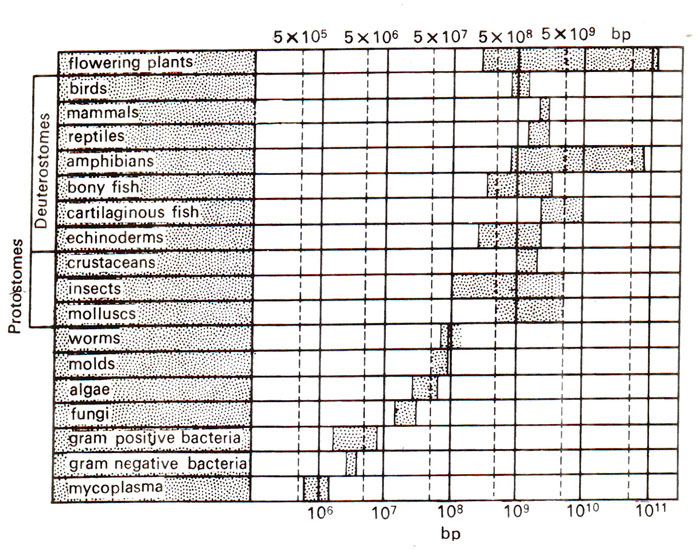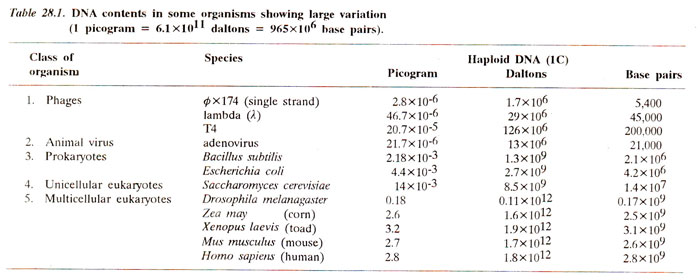Large variation in DNA content, among species of the same genus as well as among genera of the same family have been observed. This wide range of variation in the nuclear DNA contents among species within a genus, may be partly attributed to differences in chromosome numbers. However, species at the same ploidy level and with same chromosome number may either show little or no variation (e.g.
Hordeum, Avena, etc.) or may exhibit many fold differences (e.g.
Lathyrus, Vicia, Helianthus, Crepis, Allium, etc.). This interspecific variation may be continuous or discontinuous. Intraspecific variation in DNA content has also been reported in recent years, so that the variation of DNA among plants and animals is a rule rather than an exception. This variation has sometimes also been used to explain the mechanism of evolution in specific groups.
In Table 28.1 and also in Figure 28.1, contents of DNA in some plants and animals are presented, which clearly indicate that eukaryotes, in comparison to prokaryotes, have enormous DNA per cell. For instance, each human diploid cell has DNA equal to 3.5 x 10
12 daltons (1 dalton = mass of one hydrogen atom), which is equal to 174 cm of DNA.

Fig. 28.1. Variation in genomic DNA in a variety of animals and plants
Since a human body may have upto as much as l00g of DNA in all cells, this DNA in the body of a human will be as long as 2.5 x 10
10 km (more than 100 times the distance from the earth to the sun). If the haploid genome content in humans is 1.8 x 10
12 daltons, which is equal to 2.8 x 10
9 base pairs, then this genome should contain approximately as many as 3 x 10
6 genes (assuming 1000 base pairs per gene coding for nearly 300 amino acids; consult
The Genetic Code on genetic code).
However, an estimate of number of genes in humans has also been made on the basis of knowledge about the rate of mutation per locus. If average mutation rate per locus is known, and the mutation rate per individual is also known, then total number of genes can be calculated. The frequency of deleterious mutations per locus in humans is 10
-5 to 10
-6 in each generation as estimated by Muller in 1967. If number of genes is 3 x 10
6 (3 million = 3,000,000) as outlined above, then it will yield 30 deleterious mutations in each generation at the rate of 10
-5 mutations per locus. This will be an unbearable genetic load. However, the actual frequency of deleterious mutations per generation per individual has been estimated to be 0.5 against an expected frequency of 30. This mutation frequency at the rate of 10
-5 mutation per locus will give an estimate of 5 x 10
4 genes (50,000 genes). This suggests that actual number of genes in a human should be 50,000, and not 3 million (3,000,000) as estimated from DNA content. This anomalous situation has been described by some workers as
C value paradox (the haploid DNA content in an individual is described as its C value).

Fig. 28.1. Variation in genomic DNA in a variety of animals and plants
There is yet another aspect of C-value paradox involving huge variation in C-values between species, whose apparent complexity does not vary correspondingly. For instance, mammals usually contain 1-5 pg DNA per haploid genome, but the range of this DNA in salamanders extends upto 100 pg or so and in primitive angiosperms it may extend even upto 300 pg. Substantial variation in the nuclear DNA content exists even between closely related species (Fig. 28.1) and can not be easily explained and hence the phrase,
C-value paradox.






